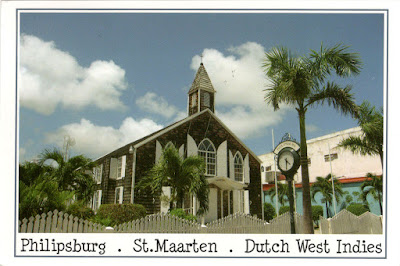 |
| 1935 The map of Saint Martin Island (1) |
Posted on 04.10.2015, 30.07.2016, 29.07.2017
Located in the northeast
Caribbean, between
Anguilla and
Saint Barthélemy,
Saint Martin is the smallest inhabited sea island divided between two nations, respectively between
France (60%) and the
Kingdom of the Netherlands (40%). The southern Dutch part comprises
Sint Maarten and is one of four constituent countries that form the Kingdom of the Netherlands, and the northern French part comprises the
Collectivité de Saint-Martin and is an overseas collectivity of France.
 |
| 1936 The map of Saint Martin Island (2) |
The main cities are
Philipsburg (Dutch side) and
Marigot (French side). The Dutch side is more heavily populated, and the largest settlement on the entire island is
Lower Prince's Quarter. The highest hilltop is the
Pic Paradis (424m) in the center of a hill chain on the French side, but both sides are hilly with large mountain peaks. This forms a valley where many houses are located. There are no rivers on the island, but many dry guts. It has a tropical monsoon climate with a dry season from January to April and a rainy season from August to December.
 |
| 1937 The map of Saint Martin Island (3) |
Ancient relics date the island's first settlers, probably
Ciboney Indians (a subgroup of
Arawaks), back to 3,500 years ago. Their lives were turned upside-down with the descent of the
Carib Indians, a warrior nation which killed the Arawak men and enslaved the women. In 1493
Christopher Columbus glimpsed the island and named it
Isla de San Martín after Saint
Martin of Tours because it was November 11, St. Martin Day, but Spain made the settlement of the island a low priority.
 |
| 2670 The map of Saint Martin Island (4) |
Instead, the French and Dutch coveted the island. While the French wanted to colonize the islands between
Trinidad and
Bermuda, the Dutch found San Martín a convenient halfway point between their colonies in
New Amsterdam (present day
New York) and
Brazil.
The Dutch, French and British founded settlements on the island. In
1633 Spanish forces captured Saint Martin from the Dutch, but in 1648
they deserted the island. Preferring to avoid an war, the French and
Dutch signed in the same year the
Treaty of Concordia, which divided the island in two, as it is now.
 |
| 3115 The map of Saint Martin Island (5) |
With the cultivation of cotton, tobacco, and sugar, mass numbers of
slaves were imported to work on the plantations, until the slave
population became larger than that of the land owners. After abolition
of slavery in the first half of the 19th century, plantation culture declined and the island's economy
suffered. In 1939, Saint Martin received a major boost when it was
declared a duty-free port. The Dutch began focusing on tourism in the
1950s.
The French needed another twenty years to start developing their
tourism industry.
 |
1938 Saint Martin - The border monument which celebrates
the peaceful coexistence of the French and Dutch on St. Martin (1) |
Currently, tourism provides the backbone of the
economy for both sides of the island. St. Martin's Dutch side is known
for its festive nightlife, beaches, jewellery, drinks made with native
rum-based guavaberry liquors, and casinos. The island's French side is
known for its nude beaches, clothes, shopping (including outdoor
markets), and French and Indian Caribbean cuisine. Because the island is
located along the
intertropical convergence zone, it is occasionally threatened by tropical storm activity in the late summer and early fall.
 |
1938 Saint Martin - The border monument which celebrates
the peaceful coexistence of the French and Dutch on St. Martin (2) |
The culture of Saint Martin is a blend of its African, French, British, and Dutch heritage. Although each side's culture is influenced by their respective administering countries, they share enough similar heritage and traditions that it can be difficult to tell where Saint-Martin ends and Sint Maarten begins. Nowadays, the number of Creoles has been surpassed by the number of immigrants, and the island's population is truly a melting pot of people from 70 or more different countries.













































